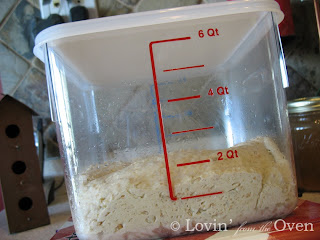One thing I used to do and I guess it's a common newbie bread maker's mistake is to over proof the dough - or in layman's terms: to let it rise too long.
Of course, you can't know that while it's happening, but you find out eventually when your dough doesn't grow when it's in the oven and you end up with a variation of a brick.
One of the best ways to avoid over proofing is to put your dough in a smaller container. My mixer is a big 8 quart bowl. Even with making two loaves, the dough is still a smallish ball at the bottom of that container. So, doubling it or tripling it's size doesn't look a heck of a lot different, but letting it rise too long can have bad effects in the baking process.
See how small this is at the bottom of the bowl? How could I really know when it has doubled in size?
This is the same dough in a smaller mixing bowl. So, one trick is to transfer the ball of dough to a smaller mixing bowl as shown here:
Kind of hard to see in the photo, but it's about 2" from the rim in a medium sized mixing bowl. It's much easier to see if it's doubled in this medium sized bowl than in a large bowl.
Here it is, all risen and ready to punch down (not literally) and to shape.
Some bakers take it a step farther and use glass and plastic containers where they can mark the starting line and the goal line for rising. So, the dough would start at say 2 quarts and rise to 4 quarts. (I might need to get these as I could use them for fermenting yogurt too!)
It's a bit easier once you've shaped a loaf to see if you've over proofed it or not, especially when you put it in a pan, but it can be tricky as times vary greatly even for a recipe you are used to making.
.JPG)




No comments:
Post a Comment